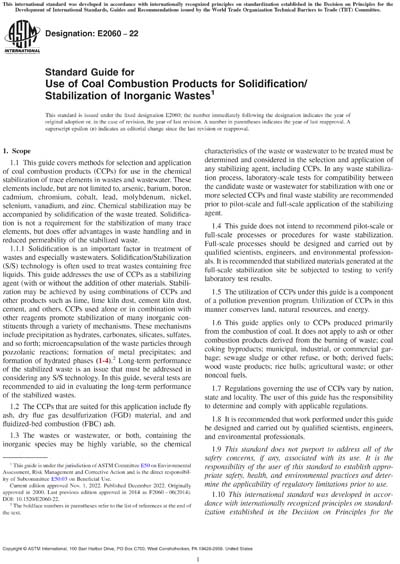Most recent
ASTM E2060-22
Standard Guide for Use of Coal Combustion Products for Solidification/Stabilization of Inorganic Wastes
1.1This guide covers methods for selection and application of coal combustion products (CCPs) for use in the chemical stabilization of trace elements in wastes and wastewater. These elements include, but are not limited to, arsenic, barium, boron, cadmium, chromium, cobalt, lead, molybdenum, nickel, selenium, vanadium, and zinc. Chemical stabilization may be accompanied by solidification of the waste treated. Solidification is not a requirement for the stabilization of many trace elements, but does offer advantages in waste handling and in reduced permeability of the stabilized waste.
1.1.1Solidification is an important factor in treatment of wastes and especially wastewaters. Solidification/Stabilization (S/S) technology is often used to treat wastes containing free liquids. This guide addresses the use of CCPs as a stabilizing agent (with or without the addition of other materials. Stabilization may be achieved by using combinations of CCPs and other products such as lime, lime kiln dust, cement kiln dust, cement, and others. CCPs used alone or in combination with other reagents promote stabilization of many inorganic constituents through a variety of mechanisms. These mechanisms include precipitation as hydrates, carbonates, silicates, sulfates, and so forth; microencapsulation of the waste particles through pozzolanic reactions; formation of metal precipitates; and formation of hydrated phases (1-4).2 Long-term performance of the stabilized waste is an issue that must be addressed in considering any S/S technology. In this guide, several tests are recommended to aid in evaluating the long-term performance of the stabilized wastes.
1.2The CCPs that are suited for this application include fly ash, dry flue gas desulfurization (FGD) material, and and fluidized-bed combustion (FBC) ash.
1.3The wastes or wastewater, or both, containing the inorganic species may be highly variable, so the chemical characteristics of the waste or wastewater to be treated must be determined and considered in the selection and application of any stabilizing agent, including CCPs. In any waste stabilization process, laboratory-scale tests for compatibility between the candidate waste or wastewater for stabilization with one or more selected CCPs and final waste stability are recommended prior to pilot-scale and full-scale application of the stabilizing agent.
1.4This guide does not intend to recommend pilot-scale or full-scale processes or procedures for waste stabilization. Full-scale processes should be designed and carried out by qualified scientists, engineers, and environmental professionals. It is recommended that stabilized materials generated at the full-scale stabilization site be subjected to testing to verify laboratory test results.
1.5The utilization of CCPs under this guide is a component of a pollution prevention program. Utilization of CCPs in this manner conserves land, natural resources, and energy.
1.6This guide applies only to CCPs produced primarily from the combustion of coal. It does not apply to ash or other combustion products derived from the burning of waste; coal coking byproducts; municipal, industrial, or commercial garbage; sewage sludge or other refuse, or both; derived fuels; wood waste products; rice hulls; agricultural waste; or other noncoal fuels.
1.7Regulations governing the use of CCPs vary by nation, state and locality. The user of this guide has the responsibility to determine and comply with applicable regulations.
1.8It is recommended that work performed under this guide be designed and carried out by qualified scientists, engineers, and environmental professionals.
1.9This standard does not purport to address all of the safety concerns, if any, associated with its use. It is the responsibility of the user of this standard to establish appropriate safety, health, and environmental practices and determine the applicability of regulatory limitations prior to use.
1.10This international standard was developed in accordance with internationally recognized principles on standardization established in the Decision on Principles for the Development of International Standards, Guides and Recommendations issued by the World Trade Organization Technical Barriers to Trade (TBT) Committee.
Content Provider
ASTM International [astm]






